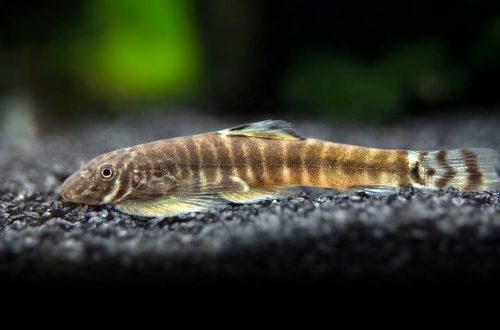
Characin pike
The striped characin pike or Characin pike, scientific name Boulengerella lateristriga, belongs to the Ctenoluciidae family. Pretty easy to keep fish, if it is in a large aquarium, equipped with all necessary equipment. Due to the high cost of the latter, only aquarists who are ready to go to significant financial costs can afford it.

Contents
Habitat
It comes from South America from the basins of the Orinoco and Rio Negro rivers in the territory of Brazil and Venezuela. Inhabits the main channels of rivers and small tributaries flowing through dense tropical forest. Water in its natural habitat has very low pH and dGH values, and is also colored dark brown due to the abundance of dissolved tannins formed as a result of the decomposition of plant organic matter.
Brief information:
- The volume of the aquarium – from 1000 liters.
- Temperature – 24-28°C
- Value pH — 4.0–7.0
- Water hardness – soft (1-10 dGH)
- Substrate type – any
- Lighting – subdued
- Brackish water – no
- Water movement – moderate or weak
- The size of the fish is 25 cm.
- Meals – live fish, fresh or frozen meat products
- Temperament – predator, incompatible with other smaller fish
- Content both individually and in a small group
Description
With its body shape, this species is very similar to the common European pike, with the exception of coloration. Adult individuals reach a length of up to 25 cm. The tail is large, the rest of the fins are small and shifted back. The pattern consists of alternating black and white stripes. Young fish look slimmer, mature fish look fuller.
Food
Ambush predator. In the wild, they feed on small fish and insects. In a home aquarium, pieces of meat from fish, mussels, freshwater shrimp and other invertebrates will be accepted. Animal products and poultry products are not allowed.
Maintenance and care, arrangement of the aquarium
Although the fish is relatively small, it needs a lot of free space, which is associated with the feeding habits of the Haracin pike, which ambush prey in a swift dash. If the tank is small, then the fish will simply hit the wall. In connection with these, the recommended volume starts from 1000 liters. The design should include areas with floating vegetation and snags – potential places for shelter.
For long-term management, it is important to ensure that the water chemistry is similar to that in which the fish live in nature. Maintaining hydrochemical indicators (pH and dGH) within the acceptable range of values, taking into account the large volume, will require special equipment and monitoring systems. The implementation of other mandatory aquarium maintenance procedures, such as replacing part of the water with fresh water or cleaning glass, removing organic waste, is also advisable to automate than to do it manually. Thus, the maintenance of the Striped pike-characin requires not small financial costs.
Behavior and Compatibility
Peaceful calm look, despite the predatory disposition, can get along with other non-aggressive fish of a comparable size. It is worth remembering that any small fish will soon be eaten.
Fish diseases
In favorable conditions, health problems do not arise. Diseases are associated primarily with external factors. For example, in cramped conditions with high concentrations of pollution and poor water quality, diseases are inevitable. If you bring all the indications back to normal, then the well-being of the fish improves. If signs of the disease persist (lethargy, changes in behavior, discoloration, etc.), medical treatment will be required. Read more about symptoms and treatments in the Aquarium Fish Diseases section.





